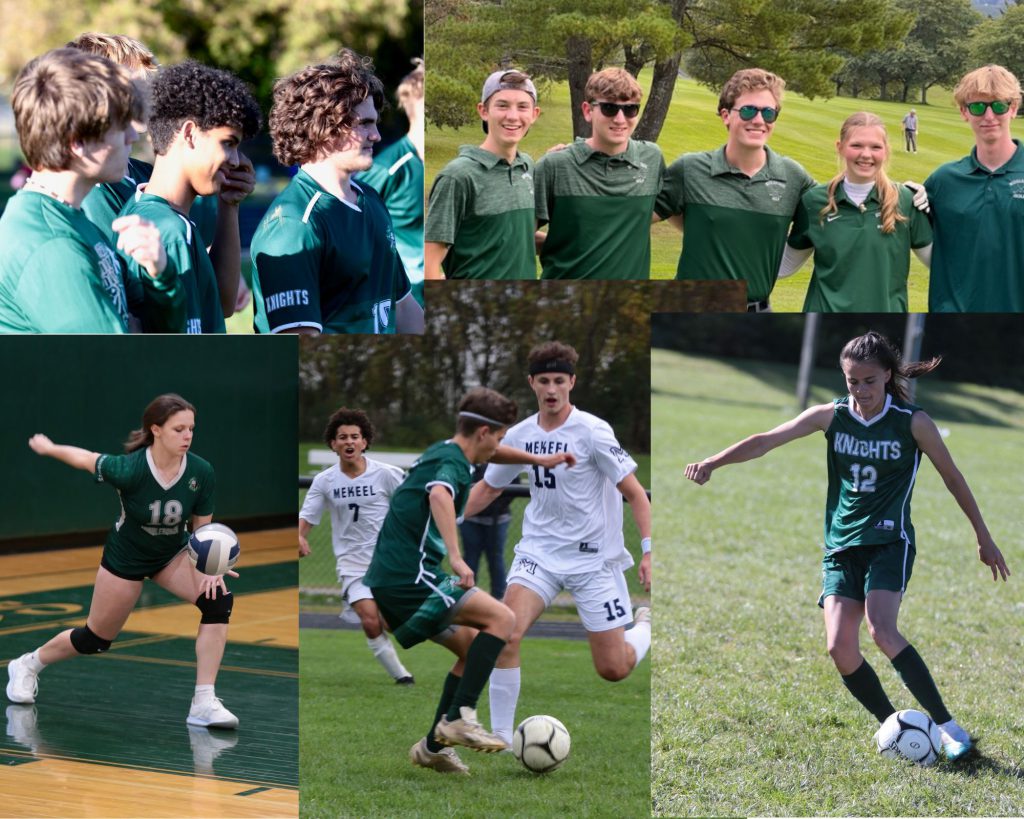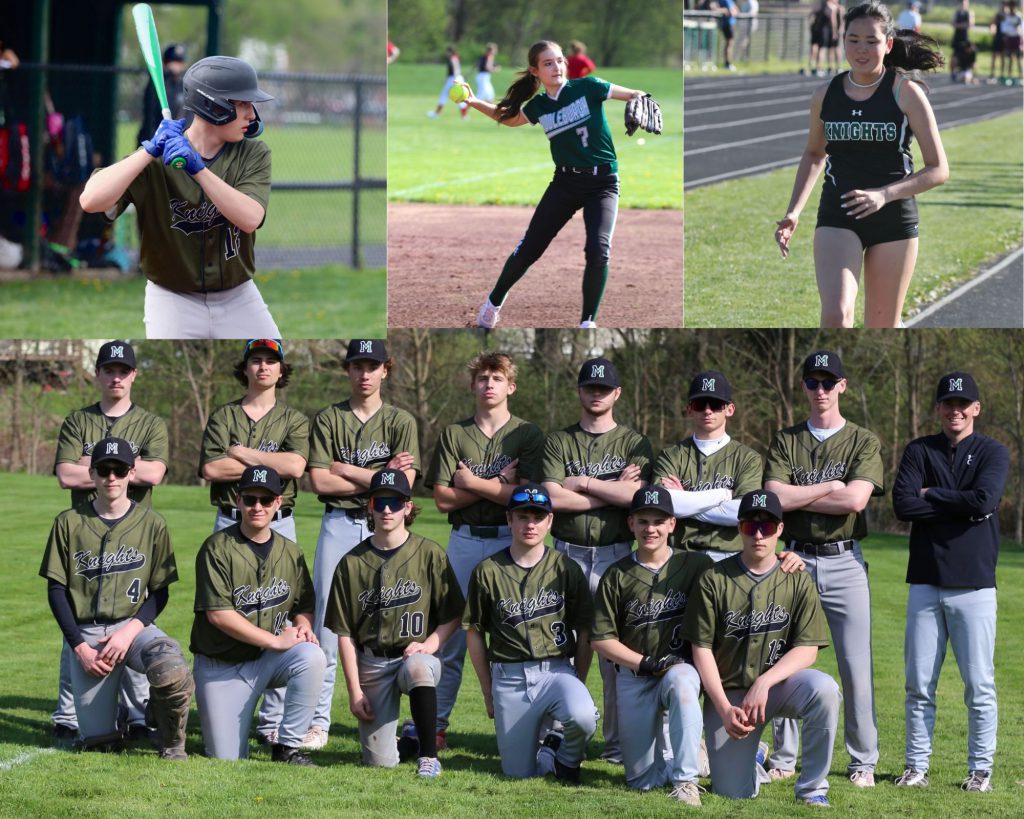Go Knights!
The Middleburgh Central School District believes athletics are an integral part of a well-balanced educational program. That’s why the district supports a broad sports program with equal access for all students, with an emphasis on maximum participation, through interscholastic and intramural activity.
Athletic Teams
The Middleburgh Central School District offers the following interscholastic sports during the fall, winter, and spring seasons.
Fall

- Girls Volleyball (modified, junior varsity, varsity)
- Golf (varsity)
- Boys Soccer (modified, junior varsity, varsity)
- Girls Soccer (modified, junior varsity, varsity)
- Boys & Girls Cross Country (modified and varsity) merged with BKW
Winter

- Boys Basketball (modified, junior varsity, varsity)
- Girls Basketball (modified, junior varsity, varsity)
- Bowling (varsity)
- Cheerleading (varsity)
- Wrestling Merged with BKW
Spring

- Baseball (modified, varsity)
- Softball (modified, varsity)
- Boys Track (modified, varsity)
- Girls Track (modified, varsity)
- Tennis (varsity)
All photo credits: Bob Roney
Booster Club
MCS Booster Club is a nonprofit organization that supports teams through concession sales and fundraising. Funds are used to provide teams with items such as banners, referees, tournaments, uniforms, video equipment and more.
The Booster Club is completely run by volunteers. Parents, siblings, alumni, grandparents, teachers, and other community members are encouraged to participate as often as they are able. All are welcome; no experience is necessary.
For more information, contact Robin Grupinski at robin.grupinski@mcsdny.org or Annette Andrew at annette3672@gmail.com. Place “Booster Club” in the subject line.
Dominic Murray Sudden Cardiac Arrest Prevention Act
The Dominic Murray Sudden Cardiac Arrest Prevention Act requires schools, students, and parents/guardians to have information on sudden cardiac arrest risks, signs, and symptoms. Please note that sudden cardiac arrest in children and youth is rare. The incidence of sudden cardiac death (SCD) on the playing field is 0.61 in 100,000.
Sudden Cardiac Arrest (SCA) is an emergency that happens when the heart suddenly stops working. SCA can cause death if not treated immediately, and even with treatment death may occur. Immediate treatment is cardiopulmonary resuscitation (CPR) and use of an automatic external defibrillator (AED). All public schools must have a staff member trained in the use of CPR and AED in school and at all school athletic events.
Preventing SCA before it happens is the best way to save a life. Both your family health history and your child’s personal history must be told to healthcare providers to help them know if your child is at risk for sudden cardiac arrest. Ask your child if they are having any of the symptoms listed below and tell a healthcare provider. Know your family history and tell a healthcare provider of any risk factors listed below.
THE SIGNS OR SYMPTOMS ARE:
- Fainting or seizure, especially during or right after exercise or with excitement or startled
- Racing heart, palpitations, or irregular heartbeat
- Dizziness, lightheadedness, or extreme fatigue with exercise
- Chest pain or discomfort with exercise
- Excessive shortness of breath during exercise
- Excessive, unexpected fatigue during or after exercise
STUDENT’S PERSONAL RISK FACTORS ARE:
- Use of diet pills, performance-enhancing supplements, energy drinks, or drugs such as cocaine, inhalants, or “recreational” drugs
- Elevated blood pressure or cholesterol
- History of health care provider ordered test(s) for heart related issues
STUDENT’S FAMILY HISTORY RISK FACTORS ARE:
- Family history of known heart abnormalities or sudden death before 50 years of age
- Family members with unexplained fainting, seizures, drowning, near drowning or car accidents before 50 years of age
- Structural heart abnormality, repaired or unrepaired
- Any relative diagnosed with the following conditions:
- Enlarged Heart/ Hypertrophic Cardiomyopathy/Dilated Cardiomyopathy
- Arrhythmogenic Right Ventricular Cardiomyopathy
- Heart rhythm problems, long or short QT interval
- Brugada Syndrome
- Catecholaminergic Ventricular Tachycardia
- Marfan Syndrome- aortic rupture
- Heart attack at 50 years or younger
- Pacemaker or implanted cardiac defibrillator (ICD)
- Enlarged Heart/ Hypertrophic Cardiomyopathy/Dilated Cardiomyopathy
SCA in students at risk can be triggered by athletic activities. To decrease any chance of SCA in a student, the Interval Health History for Athletics must be completed and signed by a parent/guardian before each sports season unless a physical examination has been conducted within 30 days before the start of the season. This form has questions to help identify changes since the last physical examination or health history was completed. School personnel may require a student with health or history changes to see a healthcare provider before participating in athletics.
Finally, the law requires any student who has signs and symptoms of pending SCA be removed from athletic activity until seen by a physician. The physician must provide written clearance to the school for the student to be able to return to athletics.
Please contact the State Education Department’s Office of Student Support Services for questions at studentsupportservices@nysed.gov or 518-486-6090.
Source information: Maron BJ, Doerer JJ, Haas TS, et al. Sudden deaths in young competitive athletes: analysis of 1866 deaths in the United States, 1980-2006. Circulation 2009;119:1085-92. 10.1161/CIRCULATIONAHA.108.804617
SCA Prevention Toolkit – Eric Paredes Save A Life Foundation (epsavealife.org)

You must be logged in to post a comment.